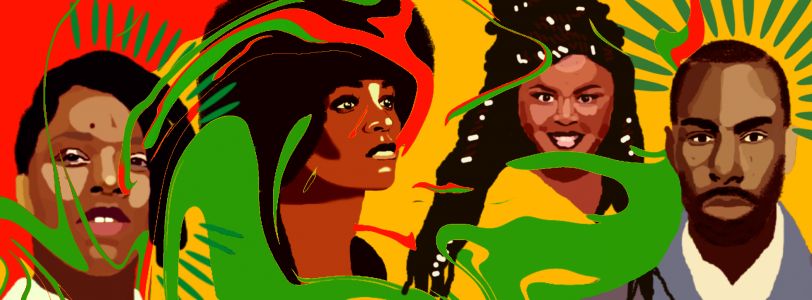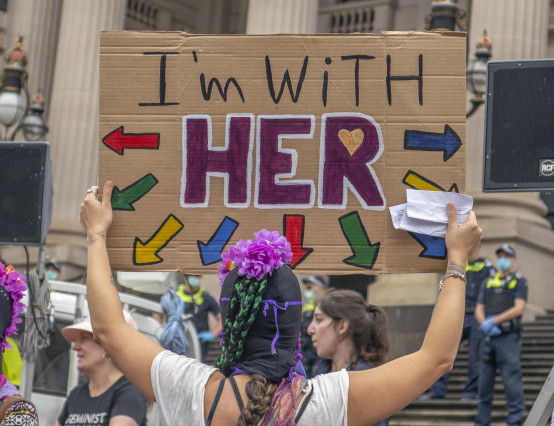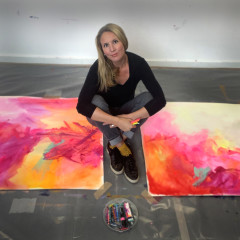As this year’s Black History Month begins, Voice has compiled a list of the Black creative pioneers who have inspired and influenced us. Culturally, trends and ideas often spring from Black communities and artists only to be co-opted, appropriated, and stolen by white artists. This month serves as a reminder to credit and remember the Black creatives who originated the art that you love, not just during Black History Month but throughout the year, every year.
Faith Ringgold
Artist Faith Ringgold has been challenging racist structures in society since she began painting in the ’50s, and as her practice expanded to include quilt-making, sculpture, performance, and a career as a celebrated children’s author, she has continued to confront and critique these issues. In the ’70s Ringgold was involved with feminist and anti-racist activism groups, protesting for better representation for black and female artists within the arts world. Ringgold’s work as an artist is varied in tone and medium, able to be jarring and overtly political in paintings such as 1967’s American People Series #20: Die, depicting a race riot, but also to nurture and guide through her children’s books which depict racism and Black history in straightforward ways to educate children, whilst also including optimism and elements of fantasy to encourage and foster a better future. Ringgold is also one of the artists to pioneer the recognition of creative techniques associated with people of colour and women as fine art, with her quilt work celebrating and championing African American crafting techniques passed down to her through generations of Black women.
Dulcie Geist
Tina Bell
The woman who invented grunge and singer of Seattle’s Bam Bam, Tina Bell has often gone overlooked by music history despite her having been credited as creating one of America’s most loved genres. Described as magnetising, regal, and high energy, Bell and her entrancing and powerful vocals over sludge-tinged guitar (attributes that came to be associated with grunge) came out of Seattle all the way back in 1983. The Melvins played support to Bam Bam while Kurt Cobain was still known only as their roadie, to give you an idea of Bam Bam’s prominence and influence in the grunge scene. So why has music history forgotten Tina Bell for so long? Bassist for Bam Bam, Scott Ledgerwood, has said that “race and gender clearly played a major role” in why Tina Bell and Bam Bam were never as successful as they should have been, with many suggesting that they were deliberately omitted from accounts of grunge’s history for the same reasons. Her son, filmmaker T.J. Martin, feels that even after her death she has still been disrespected, with all of her work and belongings being thrown out of her apartment following her death, without notifying her family. Although Bell has been overlooked for so long, those who remember her have been singing her praises whenever they can in recent years, with more and more people hearing about Bam Bam. However, the injustice remains that Bell was never allowed to tell her story herself.
Dulcie Geist
Joan Armatrading
Joan Armatrading was the first Black British female singer/songwriter to achieve international success. She has written many recognizable tracks through the decades, released 18 studio albums and was nominated for three Grammy Awards. Her music ranges from upbeat high energy 80s hits to soulful songs full of conflict. In 2011, she married her girlfriend in a civil union ceremony, and although she has never publicly spoken about being gay, her lyrics often avoid specifying gender. Armatrading’s song ‘The Weakness in Me’ talks about being in love with two people, again not specifying gender, and when asked about the song Armatrading said "It's a question of who do they choose, because they love both.” Despite being a genuinely groundbreaking artist and a successful black gay female singer-songwriters in the 1970s, Armatrading feels unsung, with what she accomplished not feeling fully reflected in her contemporary status. However 40 years of touring and a successful career later Joan Armatrading is an important British Pop Icon still writing and performing songs “about what [she sees] other people going through.”
Jay Komar
Zora Neale Hurston
Renowned novelist, ethnographer, essayist and anthropologist, Zora Neale Hurston is perhaps best known for writing one of the most prolific great American novels, Their Eyes Were Watching God. Much of the story is centred around exploring the oppression faced by Black women in the US, intricately capturing themes of self-narrativization, sexual autonomy and the subversive power of storytelling. Her work is interwoven with beautiful imagery, even within the narrative voice itself. Often these metaphors are dripping with emotion manifested in the natural world; I’ll never forget the way she depicts her protagonist’s disillusionment with her grandmother by evoking the image of an ancient tree with its roots torn from the ground by a storm. The voice she uses for Their Eyes Were Watching God is unmatched in its blend of delicacy and forthrightness. Callously dismissed during her time, Hurston’s literary works only began to receive the recognition they deserved in the mid 1970s after Alice Walker’s article ‘In Search of Zora Neale Hurston’. Nowadays her legacy lies in the influence she has had on other legendary creatives like Toni Morrison and Maya Angelou. Recently, in 2018, her nonfiction novel Barracoon: The Story of the Last “Black Cargo” was published posthumously, adding yet another work to her library.
Hamish Gray
Jean-Michel Basquiat
During his short life, Jean-Michel Basquiat became a prolific neo-expressionist painter, graffiti artist, musician, cultural figure and pop culture icon. He first started creating when he was part of a graffiti duo named SAMO, who documented the fledgling underground hip-hop and punk scene in early 1970’s Manhattan, which would become one of the most influential cultural scenes in the world. By the ‘80s, Basquiat’s artwork was showcased in galleries and exhibitions internationally. The artwork that he created seemed to be based around dichotomy, whether that be poverty versus wealth, segregation against integration, and introspection versus external to the self. He used poetry and images combined in abstract and figurative ways, usually depicting his critique on systems of racism, politics, colonialism and support for class struggle. Basquiat died at 27 of a heroin overdose, and his art has since sky-rocketed in value. A black skull painting broke records for the most expensive painting ever purchased, going for $110.5 million at auction. The artist is still heavily referenced in pop culture today, with many clothing brands and even sports teams like the Brooklyn Nets adopting the artist’s work and style.
Ash Edmonds
Melvin Van Peebles
An American actor, playwright, filmmaker, novelist and composer, Melvin Van Peebles helped to bring about the iconic blaxploitation film movement. Van Peebles found it hard to find work as a black director for decades, having to move himself and his family around Europe in the late ‘50s and throughout the 60’s, whilst making short films. He eventually found an investigative reporting job in France with the France Observateur, which led to a position at the anti-authoritarian humour magazine, Hara-kiri. Van Peebles was a prolific writer in France, publishing four novels and a collection of short stories, before making his debut feature film The Story of a Three-Day Pass, which caught the attention of Hollywood. In 1970, he directed the film Watermelon Man, which tells the story of a casually racist white man who wakes up in a Black body. Next, Melvin would release his own film, Sweet Sweetback’s Badasssss Song in 1971, a film that he directed, scripted, edited, wrote the score for, and marketed himself. The film made $10m and was lauded by the Black Panthers, who resonated with it’s political themes about Black struggle at the time. Van Peeble’s work ignited a cultural movement, where other Black directors and actors could make their own blaxploitation-style, politically charged films. This increased the amount of Black creatives found in Hollywood, and helped to highlight the racism and exploitation that was rampant at the time.
Ash Edmonds









0 Comments